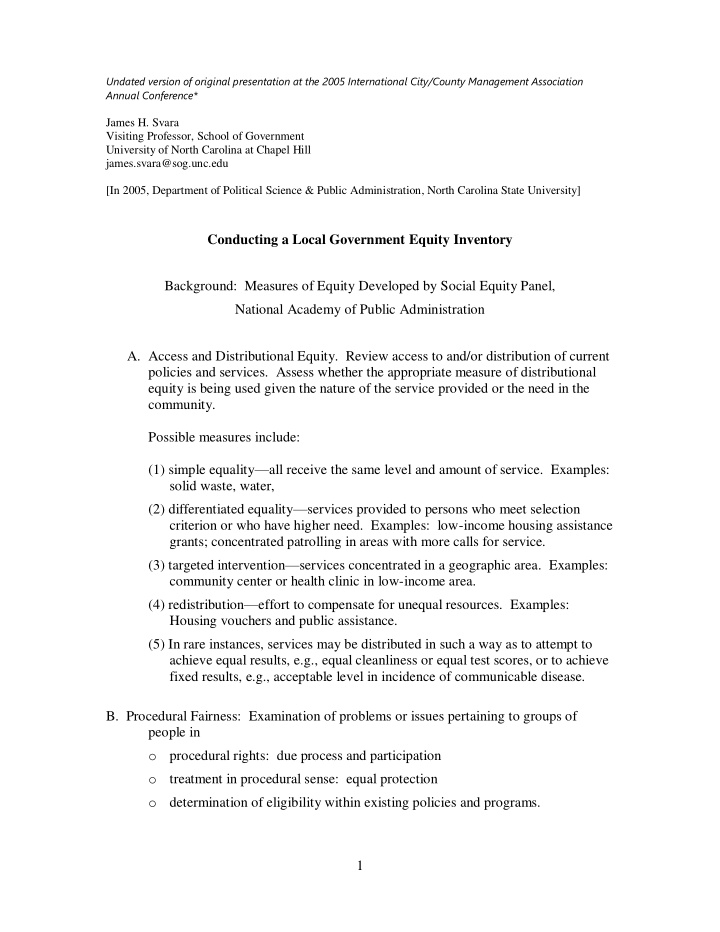



Undated version of original presentation at the 2005 International City/County Management Association Annual Conference* James H. Svara Visiting Professor, School of Government University of North Carolina at Chapel Hill james.svara@sog.unc.edu [In 2005, Department of Political Science & Public Administration, North Carolina State University] Conducting a Local Government Equity Inventory Background: Measures of Equity Developed by Social Equity Panel, National Academy of Public Administration A. Access and Distributional Equity. Review access to and/or distribution of current policies and services. Assess whether the appropriate measure of distributional equity is being used given the nature of the service provided or the need in the community. Possible measures include: (1) simple equality — all receive the same level and amount of service. Examples: solid waste, water, (2) differentiated equality — services provided to persons who meet selection criterion or who have higher need. Examples: low-income housing assistance grants; concentrated patrolling in areas with more calls for service. (3) targeted intervention — services concentrated in a geographic area. Examples: community center or health clinic in low-income area. (4) redistribution — effort to compensate for unequal resources. Examples: Housing vouchers and public assistance. (5) In rare instances, services may be distributed in such a way as to attempt to achieve equal results, e.g., equal cleanliness or equal test scores, or to achieve fixed results, e.g., acceptable level in incidence of communicable disease. B. Procedural Fairness: Examination of problems or issues pertaining to groups of people in o procedural rights: due process and participation o treatment in procedural sense: equal protection o determination of eligibility within existing policies and programs. 1
C. Quality and Process Equity. Review of the level of consistency in the quality of existing services delivered to groups and individuals. Process equity requires consistency in the nature of services delivered to groups and individuals regardless of the distributional criterion that is used. For example, is garbage pickup the same in quality, e.g., extent of spillage or missed cans, in all neighborhoods? Do children in inner city schools have teachers with the same qualifications as those in suburban schools? Does health care under Medicaid match prevailing standards of quality? Presumably, a commitment to equity entails a commitment to equal quality. D. Outcomes. Disparities in outcomes for population groups (e.g., by race or income). The analysis should include consideration of how social conditions and individual behavior affect outcomes or limit the impact of government services, i.e., what underlying conditions contribute to differences in outcomes? Equity Inventory at the Departmental Level 1. What is the purpose of the department, what services does it provide, and whom does it serve? Identify any equity issues that have arisen recently. Meaningful citizen input should be included in the assessment process. What are the equity areas that are likely to be relevant to the department and its programs? procedural equity access and distributional equity quality and process equity equal outcomes 2. Assess agency procedures to identify any equity issues? How well does the agency meet the procedural fairness standard in its current operations? What changes are needed to improve procedural fairness? 3. Assess the nature and distribution of benefits and services distributed externally, e.g., services, benefits, enforcement activities, etc., or internally, e.g., hiring, promotions, access to training, etc. What criteria for access/distributional equity are currently followed? What criteria should be followed? How well is the agency performing in terms of the preferred criteria? What impact is the agency having on equity outcomes relevant to its purpose? 4. Assess the quality of services provided. 2
Are there differences in quality by area of the city or characteristics of the client? What changes are needed to improve the uniformity in quality? 5. Assess the outcomes impacted by the department’s performance, e.g., sense of security, cleanliness of area, job placement, or health. Are there systematic differences in outcome indicators? What changes are needed to reduce disparities in outcomes? Equity Inventory at the Jurisdictional Level 1. After reviewing departmental reports, what are the areas of strength and weakness in departmental equity results? 2. Are there systemic factors that explain the results across the city or county? 3. What factors produce success and shortcomings? 4. What policy and procedural changes are needed to promote social equity? 5. What changes should be pursued in cooperation with other governments in the county or the region? * The original version is available at http://icma.org/en/icma/knowledge_network/documents/kn/Document/4434/Conducting_a_Local_Govern ment_Equity_Inventory 3
Recommend
More recommend